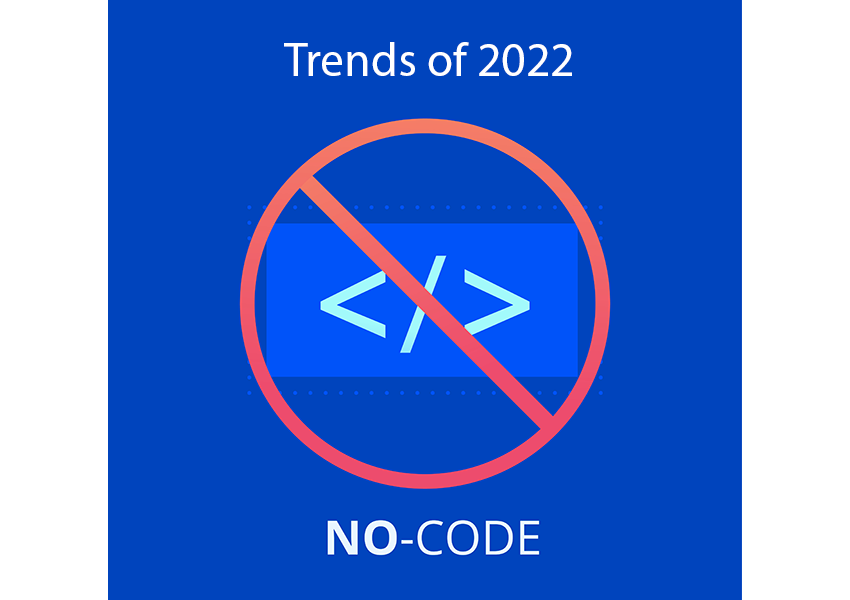The ability to launch software applications without having to write a line of code has never been more appreciated than it is today. Thanks to low code and no code tools, citizen developers or those without technical expertise are able to deliver useful applications and businesses of all sizes are able to take an extra load off their IT staff. Here are the hottest low code and no code trends for 2022.
- More Integrations
- User Interface Builders
- Instant Mobility
- Catering to Remote Workers
- Increased Adoption
- Market Segmentation
- Faster Site/App Performance
- Customer Experience Use Cases
Read on to learn more.
More Integrations
One of the hallmarks of today’s SaaS solutions is that many of them integrate easily with each other through the use of APIs. Today’s low code and no code tools don’t feature many integrations with other applications as yet but expect this to change in 2022. Having the ability to interface with a variety of web services without writing any code, such as Twitter, Slack, and more, allows no code platforms to be more adaptable to any IT environment and provides new options for legacy systems. According to Girish Redekar, Co-Founder at Sprinto:
“Integration of numerous platforms and services is a major shift that web apps have implemented this year. Rather than being specific, the apps have become more generic. Traditional programming offers a wide range of applications, but for small businesses, a common application is more helpful.”
This room for growth that low code and no code tools have is very apparent and even though there is still much more to occur, added Ron Huber, CEO of Achieve Internet.
“Today low code platforms are still in the standalone testing stage, in 2022 I believe we'll see more integration with existing platforms expanding the idea of the citizen developer.”
User Interface Builder
Creativity and functionality go hand in hand when developing mobile and web applications. Multiple platforms must be supported by today's programming platforms and they must be able to be developed without difficulty and in a short amount of time.
At the same time, developers must be able to experiment with certain risky modifications in order to provide a distinct user experience. For complete independence and flexibility, no code is compatible with JS frameworks like Angular or Vue.js that can be used to improve the user interface. According to Marc Stitt CMO at FMX:
“Low-code programming can be thought of as an extension of no-code application development. No-code platforms are simple enough for anyone without a strong programming experience to use. While also having the ability to create secure, complicated, enterprise-grade apps.”
He added that since the majority of no-code platforms have drag-and-drop features, catering to those without much experience is possible. However, for more customization, you'll need to offer JavaScript or HTML integrations. “Fortunately, it's as adaptable in terms of coding flexibility as it is in terms of implementation,” he added.
Providing a functional user interface that enables citizen developers as well as experienced frontend developers to visualize what they’re building and easily make changes will be a crucial addition for low code and no code platforms.
Instant Mobility
According to Kathryn Smithson, CMO at PathSocial:
“Build one and deploy it everywhere. Because of the advent of mobile devices such as cell phones and tablets, apps must be designed with cross-platform functionality as a basic feature. With low-code development, everything should take place automatically behind the scenes, requiring no additional effort, coding, or resources.”
Developers can’t afford to waste time when building new features for applications. This coupled with the fact that they need to create experiences for various channels means that low code tools need to allow them to build applications for cross-functional environments.
Catering to Remote Workers
Working from home and remote work have become commonplace and can no longer be considered a trend. Many businesses discovered that allowing employees to work from home increased productivity and saved money on office supplies and space. This paradigm shift necessitated numerous rapid technological changes.
However, with a decentralized IT workforce and engineering team, coping with security, troubleshooting for employees not in the office and their other day to day tasks can be a challenge. Low-code and no-code apps offer a quick and simple solution to many of the issues that have arisen as a result of the rapid migration to remote offices. As Carl Panepinto, the IT Specialist at CloudTech24 points out:
“Developers who were already swamped with to-do lists were given the responsibility of digitizing pen and paper processes. As a result of the requirement for quick solutions, many developers began to rely on low-code or no-code platforms for automation. This, too, is merely the beginning. In the following years, 500 million more apps are expected to be launched to fulfill the changing needs of the remote office. To address that need, no-code and low-code platforms are poised to take off. To handle remote workers, developers will need to design a slew of new apps, from remote background checks to e-signature solutions.”
Increased Adoption
Automation, and the fact that there is now an app for everything means that everyone from large enterprises to small and medium sized businesses and looking for ways to build their own software applications. However, having an understanding of the ever-growing number of software languages has always been a stumbling block for savvy entrepreneurs wanting to build their own applications or employees working outside of IT who want to speed up their tasks.
With low-code and no-code tools, builders can focus on the visual aspects of building software, and leverage drag and drop functionality. We’re likely to see increased adoption of these tools at companies of all sizes says Michael Butt, VP of Marketing at Verta.ai:
“Code-based software won't go away anytime soon, but low-code and no-code solutions can dramatically reduce the time it takes to build a software application. Now the technology is available to anyone with an idea, allowing a single person rather than entire teams of engineers to create apps.”
Market Segmentation
The low code and no code market is still in its infancy. As a result, there hasn’t been a clear segmentation into companies that are tailored to larger businesses as well as those specific to the challenges that medium sized businesses face. Expect that to change in 2022 says Victor Kmita, CEO and Founder, XME.digital:
“Segmentation of low code platforms for newcomers. Low code platforms were made to make BPM processes easy to digitize. Today a lot of business processes are not so straightforward as the classic model describes, so customized solutions occur - insurance, banking, IoT. A lot of industries now experience the growth of custom-made low-code solutions. Big players offer a higher level of usability, just like the latest collaboration between AWS & Figma. All low code platforms disadvantages (like security issues) now become business opportunities for newbies.”
Faster Site/App Performance
No code tools are meant to be fast but there can sometimes be slow loading times and a lot of difficulty in getting content to users quickly. With the likes of Google focusing so heavily on speed as one of their key Lighthouse parameters, these low code tools will need to improve on how quickly landing pages can be launched, points out Dominique Silvestre, CEO of Noxcod.
“The trend that will be huge for me is the speed of your page or application. This is one of the strengths of Webflow but a lot of no code tools are suffering from that, like Bubble which takes a bit of time to load or Adalo which has a huge database. This is even more crucial with the Google Core Update when you need your page to be delivered fast. I know that's an issue for a lot of our clients and force them to have a Webflow or WordPress as a landing page and Bubble for their platform.”
Customer Experience Use Cases
One of the advantages of using no code tools is that they enable citizen developers to create new applications and content experiences quickly. Through the use of these tools, Hassan Usmani, Tech Expert at YEELIGHT expects businesses to capitalize on the ability to build improved customer experiences and portals.
“Many businesses want to deliver a consistent customer experience and develop new revenue streams through online portals, but they are unable to do so since traditional web portals are slow, consume more resources, and are expensive. Low code eliminates these stumbling blocks and enables developers to create such portals quickly. Graphical user interfaces can also be made appealing, and the interface can be reused for multiple applications.”
Take Advantage of These Low Code and No Code Trends
Whether you’re a developer hoping to speed up application development and stop having to repeat monotonous tasks, or a less technical employee hoping to speed up things without asking IT for support, these low code and no code trends are worth keeping an eye on as they may be applicable to your business very soon.

 Mike Vertal
Mike Vertal




